Common Landscape Herbicides and Their Effects on Trees
Herbicides are used for landscape maintenance in a variety of settings, including lawn care, rights-of-way, roadsides, aquatic systems, and wildlife plantings. The number of existing products as well as the variety of mixtures available can result in confusion and off-label applications. These misapplications sometimes lead to injury or even mortality of tree and/or shrub species.
While it is possible to identify a specific herbicide damage through vegetation and soil analyses, these procedures are expensive and relatively limited (e.g., testing for one compound at a time). More typically, an individual suspecting herbicide damage chooses to rely on the observable damage to plant material.
This publication discusses the effects of commonly encountered herbicides on woody species in landscape settings. In addition, some specific herbicide symptoms are detailed to aid with diagnostic identification of specific herbicides. These discussions assume that herbicides were used according to labeled application rates and timing suggestions. Off-label herbicide rates are considered a misapplication; in these cases, otherwise “safe” herbicides may injure trees.
This publication does not list all products permissible for use in Mississippi and is only intended to provide general guidelines for safe/unsafe herbicide use near trees. Herbicides are listed by active ingredient and one commonly used product name. If you are unsure of specific recommendations for your product or for your desired application, please consult your local MSU Extension office or Extension forestry specialist before using the information found in this publication.
Herbicide Use Categories
In some instances, herbicides are not intended to be species-specific, and the applicator’s goal is to control as much vegetation as possible. However, most landscape applications are intended to control one or more herbaceous species while leaving others unharmed. In these efforts, applicators select herbicides based on the suitability of that herbicide to control targeted vegetation. As such, this publication categorizes herbicides based on their effectiveness at controlling undesired vegetation while leaving desired vegetation undamaged. Several of these categories are discussed below.
Pre-emergent Turf Herbicides
The herbicides listed below are commonly used in lawn settings to control a variety of undesired annual grass and broadleaf species. These herbicides include indaziflam (Specticle), pendimethalin (Pendulum), simazine (Princep), atrazine (Aatrex), prodiamine (Barricade), and dithiopyr (Diminsion). When applied correctly, woody species have very little root uptake of these herbicides. In addition, these herbicides are applied as pre-emergent treatments (before foliage appears) when most woody species are dormant. Subsequently, use of these herbicides does not typically result in tree or shrub damage. Always be aware of label cautions regarding soil pH, texture, and other factors that may be a concern when susceptible woody species are present.
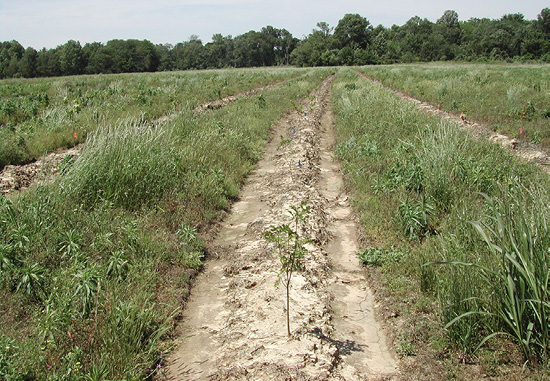
Post-emergent Landscape Herbicides
While products mentioned in the preceding paragraph are useful in pre-emergent control of annual grasses and weeds, some can also be used for post-emergent application (after foliage emerges) around woody species, as well. In addition to these herbicides, several others are available for controlling a variety of problematic species often encountered in landscape settings. These include metsulfuron methyl (MSM-turf), sulfosulfuron (Certainty), halosulfuron (Sedgehammer), 2,4-D, dicamba (Banvel), aminopyralid (Milestone), MCPP (Mecoprop), picloram (Grazon P+D), triclopyr (Remedy), clopyralid (Transline), imazaquin (Image), imazapyr (Ortho GroundClear Vegetation Killer Concentrate), quinclorac (Paramount), and trifloxysulfuron (Monument). These products are labeled for a variety of uses, but their application may be prohibited in some cases. For example, a product that is acceptable for pasture usage may not be used in lawn settings. Consequently, these herbicides are often misapplied and used in off-label applications. Follow label directions carefully to help minimize negative effects frequently encountered with off-label use.
When properly applied, most of these herbicides can be used near trees and shrubs; however, stringent consideration of environmental factors is often mandatory for use in these settings. Some of these herbicides exhibit a tendency to accumulate in higher pH soils, and their repeated use may damage or kill some woody species. In addition, the nature of application (post-emergent) increases the chance of non-target contact during applications because of wind drift.
Woody species can be negatively affected if herbicide drift comes into contact with foliage. Depending on the herbicide involved, this damage can manifest in a number of ways that will be described later. However, trees exposed to low levels of drift often recover if subsequent herbicide exposure is avoided. Depending on the herbicide and the species exposed, greater levels of herbicide drift can cause tree mortality. Mortality and severe damage are especially prevalent in cases where multiple incidences of drift have occurred, or when a species is particularly susceptible to a specific herbicide.
Some of the herbicides listed above are available in both amine and ester formulations. Volatilization and subsequent damage may occur if applying ester formulations of these herbicides in warmer temperatures. Using amine formulations reduces the chance of volatilization in higher temperature applications.
2,4-D, MCPP (Mecoprop), triclopyr (Remedy), aminopyralid (Milestone), clopyralid (Transline), dicamba (Banvel), picloram (Grazon P+D), and quinclorac (Paramount) are growth regulators or hormonal herbicides because they mimic naturally occurring growth regulators in plants. At recommended rates for broadleaf control in landscape settings, ground applications of 2,4-D, and MCPP are not typically injurious to woody species through root uptake. However, drift contact with foliage will result in leaf distortion and browning. Typically, drift of these herbicides does not result in woody species mortality but should still be avoided if possible. However, when rates exceeding label recommendations are used, 2,4-D and MCPP can be absorbed through the roots of woody species and result in injury and/or mortality.
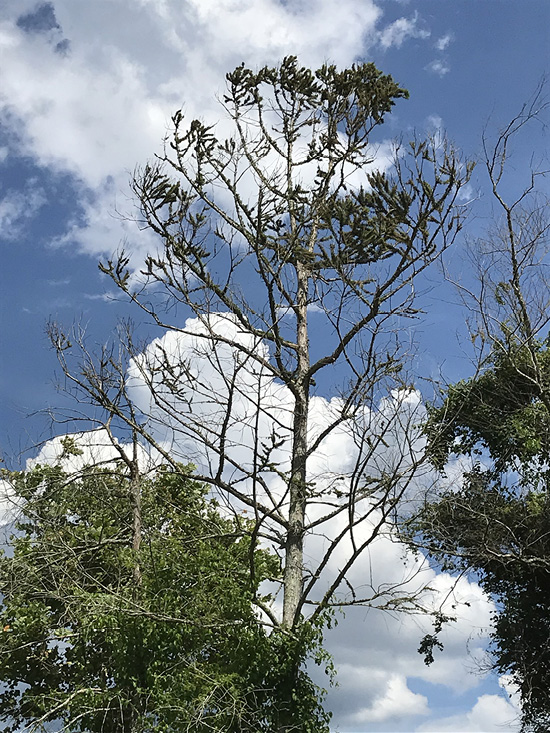
Aminopyralid (Milestone), triclopyr (Remedy), clopyralid (Transline), and quinclorac (Paramount) are similar to 2,4-D and MCPP in both chemistry and effect on most woody species in landscape setting applications. However, in cases of drift, aminopyralid and triclopyr cause more severe damage and even mortality if foliage is contacted, while clopyralid and quinclorac usually only result in chlorosis (yellowing) of impacted leaves without causing permanent damage. In addition, root uptake by leguminous species (e.g., locust, redbud, mimosa) can be problematic with aminopyralid, triclopyr, and clopyralid, causing serious injury/mortality in some instances.
Dicamba (Banvel), is often used to control resistant species of broadleaf weeds in turf applications. It is also sometimes recommended to control woody species in rights-of-way, along fence lines, and for “clean-up” in non-cropland settings. While rates of dicamba commonly prescribed for use in landscape applications rarely cause woody species mortality, the herbicide is absorbed through the root systems of these species. This typically results in minor damage (easily observable in the form of leaf deformation and twig/branch dieback), but it can result in serious injury and/or mortality if dicamba is applied at greater than recommended rates and/or in repeated applications inside the root zone of woody species.
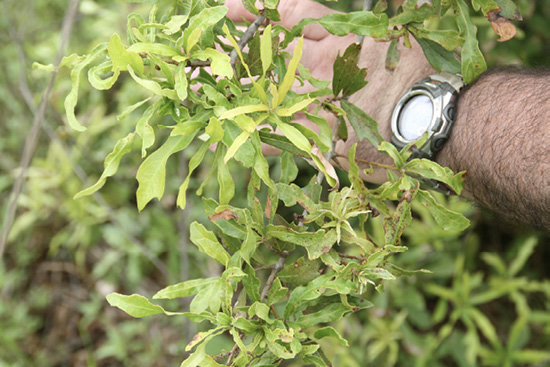
Picloram (Grazon P+D) is a component of several right-of-way and pasture products; however, it is often encountered in off-label use in lawns. While it is typically prescribed for broadleaf and brush control, it very effectively controls tree species. It is absorbed through both root and foliar exposure and will cause serious damage and/or mortality of many woody species if exposure is more than minimal. In addition, higher prescription rates of picloram (e.g., brush-control rates) often result in off-site movement via precipitation runoff. Serious unintended off-site impacts often result, and the soil persistence of picloram can be 1 year or longer.
Imazaquin (Image), imazapyr (Ortho GroundClear Vegetation Killer Concentrate), metsulfuron methyl (MSM-turf), sulfosulfuron (Certainty), halosulfuron (Sedgehammer), and trifloxysulfuron (Monument) are acetolactate synthase (ALS)-inhibiting herbicides, also known as amino acid synthesis inhibitors. ALS is an enzyme used in the synthesis of amino acids vital to growth and survival of plants. These herbicides are typically broad spectrum (control many species across broad vegetative categories). They can be absorbed by roots and foliage and translocate to the site of active growth in plants.
Woody species exhibit varying degrees of susceptibility to different products in this group of herbicides. Low levels of exposure usually only result in chlorotic leaves that become brown over time. Subsequently, leaves developing after treatment will be distorted and chlorotic, and twig/branch dieback may occur.
Imazaquin (Image), is often prescribed for control of problematic sedge and broadleaf species in lawn settings. When labeled rates for lawns are applied, imazaquin does not injure woody species through root uptake. However, drift contact with foliage can result in leaf damage in susceptible species.
While closely related to imazaquin, imazapyr is more injurious to broadleaf woody species. In forest management, imazapyr is the chief ingredient in several site-preparation products designed to completely control vegetation on sites being prepared for replanting. Several products containing imazapyr (e.g., Ortho GroundClear Vegetation Killer Concentrate) are marketed for home use to control unwanted vegetation.
Even though these products contain minimal quantities of imazapyr, their use is discouraged within the dripline of hardwood trees and shrubs. However, end users of these products often use them off-label for lawn maintenance. At very low rates, imazapyr use may only result in slight damage, but severe damage and/or mortality to susceptible woody species increases with higher rates of imazapyr. Chlorosis appears first in new leaves, and necrosis spreads from this point outward.
Metsulfuron methyl (MSM-turf), sulfosulfuron (Certainty), halosulfuron (Sedgehammer), and trifloxysulfuron (Monument) are all ALS inhibitors but are members of a different group of herbicides called sulfonylureas (SUs). SUs are typically applied at very low rates and are very effective on a wide range of grass and broadleaf species. In addition, the environmental half-life of these herbicides is relatively short (a few days to a few months), making them attractive for use in landscape work. When labeled rates and timings are followed, the SUs typically do not result in injury to woody species through root uptake. Foliage exposure to drift can result in leaf damage in susceptible species. Damage through root uptake of susceptible species can sometimes occur if label rates are exceeded.
Post-Emergent Grass Herbicides
Several herbicides are available for post-emergent control of grasses in turf maintenance. Historically, MSMA (Target 6 Plus) was labeled for use in these settings. The compound worked well, was not absorbed through the root systems of woody species, and did not translocate throughout the plant in cases of contact through drift. However, the Environmental Protection Agency banned use of MSMA in landscape applications due to concerns that it might contaminate groundwater with arsenic (present in MSMA in organic form).
Currently, the two grass herbicides most commonly encountered in landscape application are fluazifop-P-butyl (Fusilade) and clethodim (Select). Properly implemented ground applications of these products will not result in damage to woody species. However, drift contact with leaves can result in damage if crop oil is used as a surfactant. Crop oil coming into contact with woody foliage will cause leaf browning but rarely mortality.
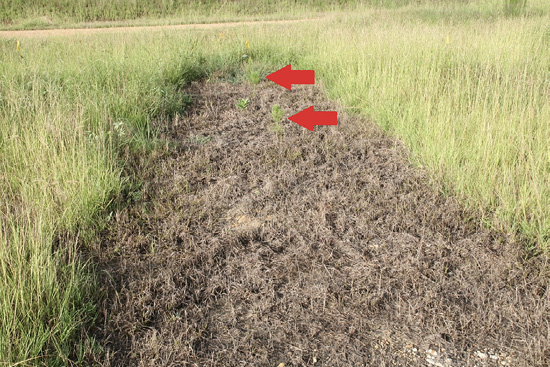
Post-emergent Nonselective Herbicides
These herbicides are used for post-emergent nonselective treatment of undesired grasses, broadleaf weeds, and brush species. Common herbicides in this group are glyphosate (Roundup), diquat (Reward), and paraquat (Gramoxone). These herbicides are absorbed through foliage and have very little root activity. Damage to woody species does not occur when ground applications are properly implemented. However, severe damage and/or mortality may occur in cases of wind drift where these herbicides contact leaves, green bark, or root suckers.
Glyphosate drift can result in serious damage to woody species due to translocation throughout the plant. Damage will typically appear as small necrotic spots where drift contacted leaves. Twig and branch dieback may occur in instances of heavier drift. In addition, while glyphosate is not readily absorbed by root systems of woody species, its use can result in damage to trees with exposed roots that are damaged by lawn equipment.
Diquat and paraquat are contact herbicides, meaning they do not readily move within plants. While leaves exposed to drift will be damaged, mortality typically does not ensue in hardwood tree species. Repeated incidences of drift should be avoided, however. Paraquat is especially damaging to pine species and often results in severe damage and/or mortality. This is especially evident in the Mississippi Delta where paraquat is used for late-winter/early-spring “burndown” in agricultural settings.
Soil Sterilant Herbicides
Soil sterilants are herbicides intended to control growth of all plants for a long period of time (typically longer than a year). Heavy rates of several available herbicides can serve as soil sterilants, but the most commonly encountered herbicide classed as such is tebuthiuron (Spike). Imazapyr (Arsenal AC) is often used at off-label levels that cause it to become a sterilant. Both are extremely effective in controlling woody plants and are easily absorbed by their root systems.
These two herbicides often cause damage when they are used to control vegetation around sidewalks, driveways, and graveled lots. Often the end users of these products do not read label warnings and do not understand the effectiveness of these herbicides when applied at soil-sterilant rates. Consequently, accidental damage and/or mortality occurs in nearby shrubs and trees.
Imazapyr is relatively soil stable and only affects vegetation inside application areas (including vegetation with root systems that extend into treated areas). Tebuthiuron is more water-soluble and can leach or move in surface runoff onto unintended areas. In addition, at sterilant rates, both herbicides have long half-lives and can be extremely damaging to woody species for periods of a year or more.
Another compound that can reach soil-sterilant levels for plants is salt (table salt, sodium chloride, NaCl). Salt has been used to sterilize soils for thousands of years. Historically, toxic levels of the compound were plowed into soils as a form of biological warfare to prevent future agricultural production. When salt reaches toxic levels, soil nutrients are replaced by sodium ions and become unavailable to plants. Root absorption causes chloride to accumulate in leaves and hinder photosynthetic ability.
Currently, well-meaning individuals who want to avoid the environmental and health effects of herbicides sometimes use salt to control landscape vegetation. They often apply salt solutions in walkway crevices and graveled drives to control unwanted herbaceous vegetation. Remedial treatment is time-consuming and expensive, involving removal and replacement of affected soils.
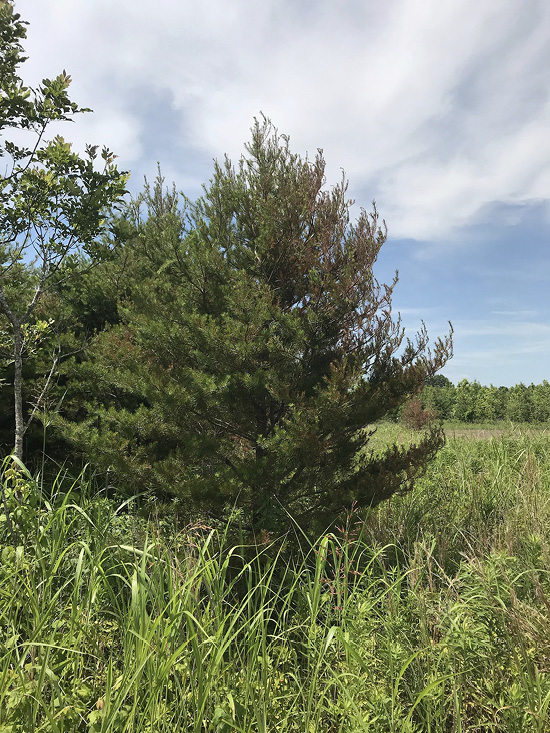
Herbicide Symptomology Terms
Diagnosing injury using symptomology can be difficult. Damage manifests differently not only by the specific herbicide used, but also by concentration and species susceptibility. In addition, the presence of environmental factors with the ability to produce similar injury is always possible. A combination of various damage symptoms are used to diagnose specific herbicides. Several of these symptoms are described below.
Chlorosis
Chlorosis is caused by chlorophyll loss and subsequent yellowing of foliage. Photosynthesis disruption can result from a variety of factors (e.g., nutrient deficiency, shading, herbicide damage). Chlorosis from herbicide damage will typically be bright yellow in the interveinal space contrasted with bright green secondary veins.
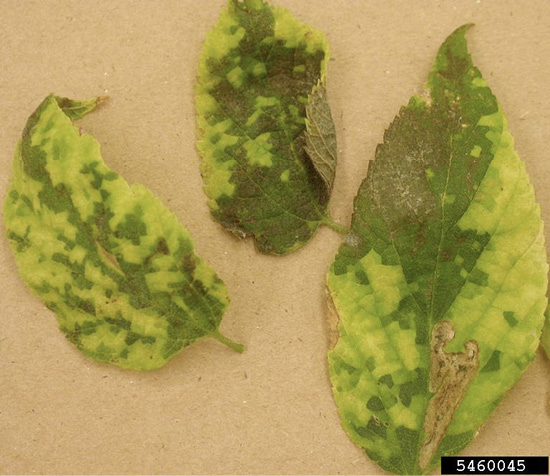
Epinastic Growth
Abnormal development of plants caused by faster growth of tissue on the upper portion of stems and petioles causing bending, twisting, cupping, or other distortion.
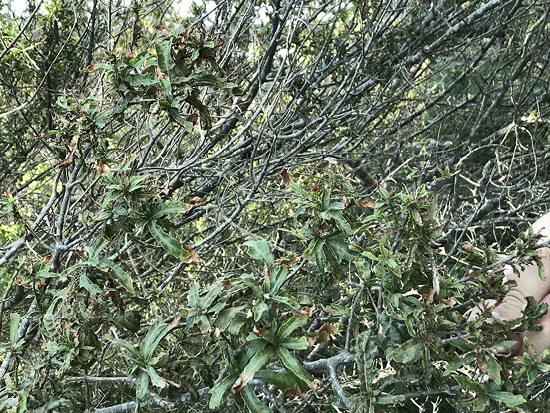
Foliar Spotting
Appearance of necrotic or chlorotic “spots” where tissue damage has occurred. Typically a result of drift contact.
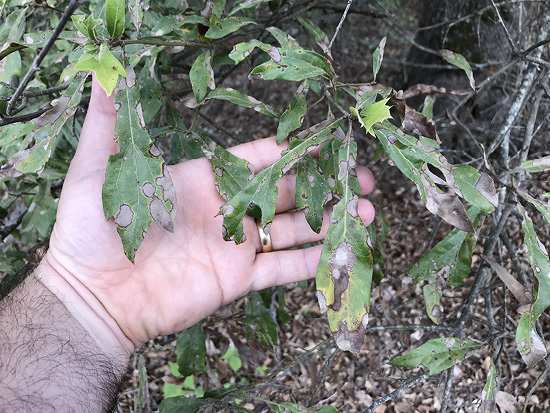
Leaf Blistering
Abnormal cell division in plant tissue that leads to the appearance of blisters or puckering on leaf surfaces.
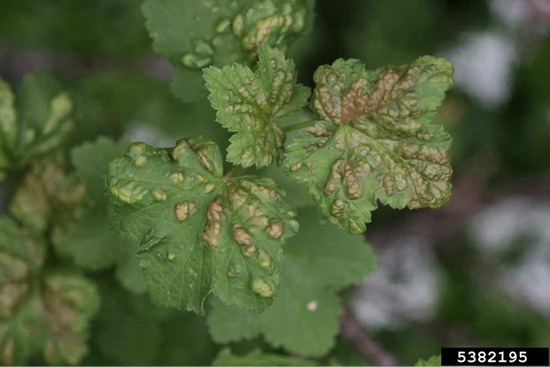
Leaf Cupping
Abnormal leaf development in which leaf tissue produces a cupped appearance.
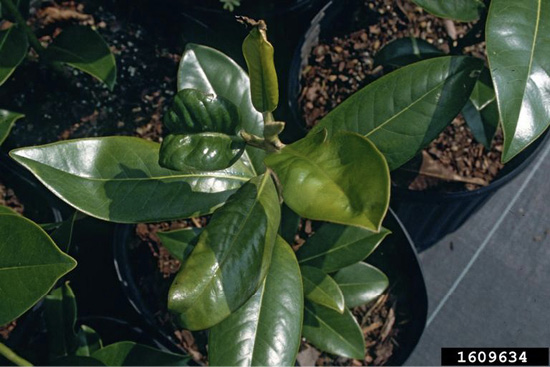
Necrosis
Browning and desiccation of plant tissue caused by tissue death. Often starts as watery lesions leading to tissue desiccation and subsequent death of affected tissues.
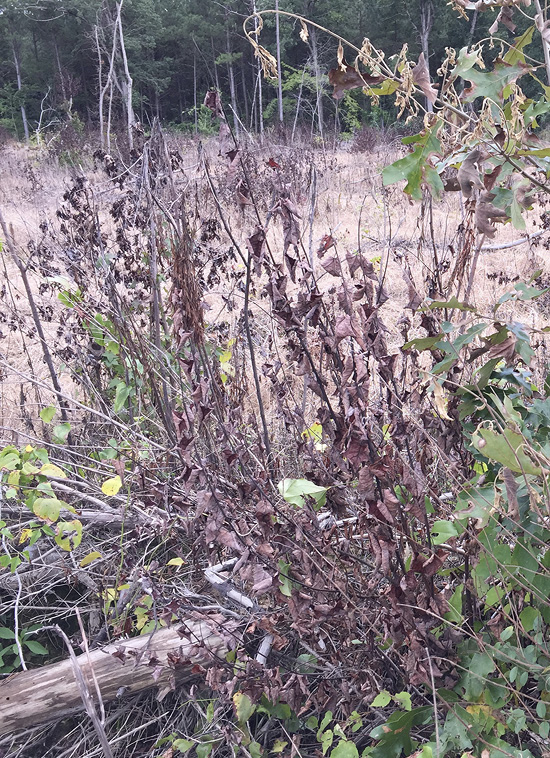
Witch’s broom
Deformity where a dense mass of shoots emerges from a single point. The resulting shoot mass resembles a broom.
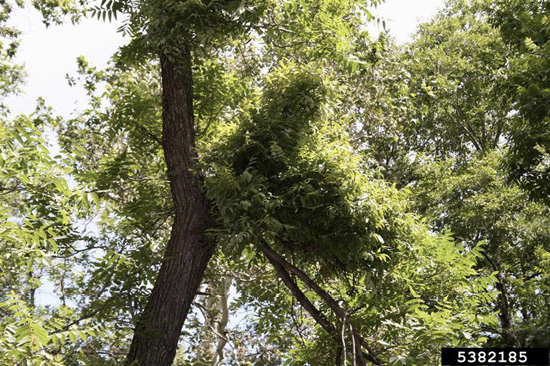
Herbicide Symptomology
Growth-Regulator Herbicides (Hormonal Herbicides)
While plants may possess differing sensitivity to various growth-regulator herbicides (hormonal herbicides), when exposed to damaging levels of these chemicals, basic symptomology is similar. Herbicides commonly encountered in this group include 2,4-D, MCPP (Mecoprop), triclopyr (Remedy), aminopyralid (Milestone), clopyralid (Transline), dicamba (Banvel), picloram (Grazon P+D), and quinclorac (Paramount).
Damage severity from these herbicides depends on the concentration to which the plant has been exposed. Common lower concentration symptoms include shoot tip twisting, epinasty in foliage, chlorosis, and parallel leaf venation. Exposure to higher concentrations often results in severe chlorosis, necrosis in shoot tips and leaves, and even mortality. Leaf necrosis, dieback, and mortality are more prevalent in instances of heavy exposure to dicamba and picloram. Symptoms are prominent on new growth, and current-year twigs/shoots may be noticeably twisted and flattened.
Root-Growth-Inhibiting Herbicides
These herbicides rarely cause tree or shrub damage. However, rates exceeding label limits and in some cases pH or soil texture, sometimes result in damage to woody species.
Landscape herbicides included in this class include pendimethalin (Pendulum), prodiamine (Barricade), and dithiopyr (Diminsion). Root damage is not typically observed in woody species, but damage to foliage from drift may occur. Basic symptomology can include swollen or brittle twigs/leaf petioles due to mitotic inhibition and new leaf deformation resembling epinastic growth.
ACCase-Inhibiting Herbicides (Lipid Synthesis Inhibitors)
ACCase inhibitors are used primarily for grass-control treatments. Simazine (Princep), fluazifop-P-butyl (Fusilade), and clethodim (Select) are the most commonly encountered landscape herbicides in this group. These herbicides are absorbed through foliage and rarely result in damage to woody species when applied per label instruction. ACCase-inhibiting herbicides primarily affect monocot species (e.g., grasses) by inhibiting an enzyme that is important for membrane synthesis.
Typically, woody species are resistant to this class of herbicide; however, drift sometimes results in foliar contact and subsequent damage to woody species. Often this damage is from the surfactant used rather than the herbicide itself. Crop-oil surfactants are particularly problematic. There are a few woody species with demonstrated sensitivity to this class of herbicide, including groundcover junipers and azalea species. Basic symptomology includes interveinal chlorosis, wilting, necrosis resulting in dieback, and mortality in instances of severe exposure.
Cellulose Biosynthesis-Inhibiting Herbicides
Herbicides in this group limit cell division in developing root tips by inhibiting cell division. They are typically applied pre-emergent for broadleaf weed control. Indaziflam (Specticle) is the herbicide in this class that is commonly encountered in landscape settings. Damage to woody species is rare when label recommendations are followed, and any injury encountered is typically the result of drift. General symptomology in scenarios of heavy drift includes chlorotic and puckered foliage (especially at shoot tips), leaf distortion, purpling of leaves, and necrosis. Stem girdling may occur at the soil line, resulting in stem swelling above that point with wilting and necrosis of the aboveground portion of the stem.
ALS-Inhibiting Herbicides (Amino Acid Synthesis Inhibitors)
ALS inhibitors are used for pre- and post-emergent, broad-spectrum plant control in multiple applications, including agriculture, forestry, rights-of-way maintenance, and range and turf maintenance. They are readily absorbed by roots and foliage and are translocated to growing sites in plants. These herbicides inhibit production of an enzyme (acetolactate syntases, ALS) that is vital to biosynthesis of branched-chain amino acids. Metsulfuron methyl (MSM-turf), sulfosulfuron (Certainty), halosulfuron (Sedgehammer), trifloxysulfuron (Monument), imazaquin (Image), and imazapyr (Ortho GroundClear Vegetation Killer Concentrate) are all ALS inhibitors.
Basic herbicide symptomology will be similar for this group, but intensity of these symptoms depends on the herbicide, rate used, and species susceptibility. Low exposure levels typically result in chlorotic leaves that are often shiny or mottled in appearance and turn purplish/reddish on the lower surface; they may become necrotic over time. Older foliage may appear wilted, crinkled, and necrotic. New growth often exhibits distorted chlorotic leaves, and twig/branch dieback may occur.
With greater levels of exposure to ALS-inhibiting herbicides, woody species growth slows/ceases as meristematic stem tips die, followed by stem dieback. Leaf buds below dead tissue emerge and start new growth that is stunted and distorted. New stem growth will typically exhibit shortened internodes and multiple branching patterns. Mortality often ensues by the following growing season.
Photosynthesis-Inhibiting Herbicides
Herbicides in this class are commonly used for post-emergent, nonselective, broad-spectrum treatment of vegetative species. Common herbicides in this group are diquat (Reward), paraquat (Gramoxone), and atrazine (Aatrex). Diquat and paraquat work by interfering with the photosynthesis system of plants through electron diversion and cell membrane destruction. Electrons flow from the photosynthesis process to molecular oxygen, creating damaging free radicals that rapidly destroy cell membranes and cause chlorosis, desiccation, and eventual necrosis. These herbicides are also known as “contact herbicides” because translocation within the plant does not occur and resulting damage is localized to the point of herbicide contact.
Damage is rapid and typically appears as “spots” of necrotic leaf tissue in cases of low-level drift. Heavier drift contact can result in mortality. The most extensive use of paraquat is during agricultural spring “burn-down” when most hardwood species are dormant. Damage of these species from this class of herbicide may be negligible, but it is possible if application occurs after trees break dormancy. However, due to their evergreen status and extreme sensitivity to paraquat, pines are very susceptible to drift in areas where this herbicide is sprayed for agricultural burn-down.
Atrazine is a photosynthesis-inhibiting herbicide; however, it differs in the way it prevents photosynthesis compared to paraquat and diquat. Proteins are bound in a manner that blocks electron transport and ceases the fixation of carbon dioxide at a late stage of photosynthesis. At this point, reactive molecules are created that cause lipid and protein membrane destruction, resulting in desiccation and disintegration of cells. Basic symptomology includes chlorotic (interveinal and whole-leaf) foliage, with necrosis beginning around leaf margins and progressing inward. Branch and twig dieback and mortality follow.
Aromatic Amino Acid-Inhibiting Herbicides
Glyphosate (Roundup) is the only herbicide commonly encountered in landscape settings in this class of herbicides. Numerous products containing glyphosate are used in turf and range, forestry, agriculture, aquatic system, and rights-of-way maintenance. Many concentrations and formulations are encountered; however, basic symptomology is similar for all. The herbicide is foliar-active only, and damage rarely occurs except through directed application or drift contact.
The typical progression of glyphosate damage is chlorotic foliage that turns necrotic over time. Higher levels of exposure result in mortality over the course of days to weeks. In scenarios of late-season exposure, nonmetabolized glyphosate can be translocated to root systems and translocate back through the plant to growing points and continue its effects. Carry-over symptomology includes witch’s broom, epinasty and puckering of foliage, stunted growth, chlorosis, bark splitting, and mortality.
Soil-Sterilant Herbicides
If used at levels exceeding labeled rates, many of the herbicides discussed above can reach sterilant concentrations. However, the two most common soil-sterilant herbicides encountered in landscape settings are tebuthiuron (Spike) and imazapyr (Arsenal AC). Imazapyr symptomology has been discussed above, but intensified damage can be expected at rates reaching sterilant levels. Typically, soil sterilization is not intended with imazapyr use and is a consequence of accidental or uneducated high-rate applications.
Tebuthiuron is a photosynthesis-inhibiting herbicide that works in the same manner as atrazine (described above). Basic symptomology is similar, including chlorotic (interveinal and whole-leaf) foliage, necrosis beginning around leaf margins and progressing inward, and branch and twig dieback and subsequent mortality. However, much more intense symptomology is expected with this herbicide.
Another soil sterilant encountered is salt (table salt). Often, people use salt to control unwanted vegetation when they want to use a non-synthesized herbicide. Unfortunately, salt accumulation can reach sterilant concentrations, with basic symptomology including necrotic foliage (pine needles brown from tip to needle base; hardwood species’ leaves brown from leaf margin inward), lack of reemerging foliage and flowers in the spring (hardwoods), witch’s broom, reduced new growth, dieback of limbs, and possible mortality. Salt damage is often more severe on the side of the plant closest to the point of application.
Diagnosing Herbicide Damage
Diagnosing herbicide injury symptoms can be very difficult. Many herbicides have similar damage symptomology, and the actual herbicide used may not be known. Also, a variety of nonherbicide environmental factors may result in comparable damage symptoms. Accurate diagnosis of herbicide damage often requires an expert in identifying herbicide injury and herbicide activity in plants. Chemical analysis is possible but only feasible while detectable levels of the herbicide are still present in plant tissues or in nearby soil. These tests are expensive and only applicable to specific herbicides (i.e., a test for glyphosate will not detect imazapyr), so separate tests must be done for different herbicides.
Accurate diagnosis requires knowledge of the effects of various herbicides on different plant species. It is also necessary to know what healthy specimens look like. Some ornamental species have yellow, white, variegated, or other “non-green” foliage, and some species have naturally twisted stems. A lack of knowledge of these characteristics might lead to an incorrect diagnosis of herbicide damage.
Knowledge of herbicide modes of action, half-life information, and effects of different rates of potential herbicides involved are all important in identifying damage. Most herbicides do not work instantaneously; damage symptoms occur from days to weeks after exposure. Foliar exposure typically results in faster observable damage than damage from root absorption of soil-active herbicides.
Other plants growing nearby can also offer insight as to potential herbicides used. Damage occurring in two or more species indicates herbicide exposure, whereas damage to a single species is likely to be the result of a pathogen or insect infestation. Location can also be helpful in determining herbicide damage. Proximity and direction from known herbicide-application areas may be useful when combined with observations of damage on adjacent nonwoody plants.
Water-mobile herbicides may move in the direction of water flow during precipitation events. Root systems of trees and shrubs may be exposed if they extend into this path (remember that tree root systems extend often two or three times the height of the tree from the trunk). Finally, weather records may be useful in determining cases of drift based on environmental conditions at the time of nearby herbicide applications.
Treatment Possibilities
Damage and recovery from herbicide exposure depend on multiple factors. Resistance to herbicides varies by species. In addition, the rate, timing, and environmental conditions before, during, and after exposure can determine the degree of damage. Healthy, vigorous plants receiving only drift exposure to most herbicides often survive with slight foliar damage only. Conversely, stems exposed to greater levels of herbicide tend to exhibit increased damage and mortality.
Fast-acting herbicides like paraquat normally cause spotting or leaf necrosis, but they usually do not translocate into non-contact portions of the plant. Mortality is uncommon in these instances. Slower-acting and soil-active herbicides are more likely to cause long-term damage through stunting and mortality.
Timing of exposure plays an important role in the possibility of recovery, as well. Different herbicides have different periods of time when greater damage is expected (e.g., pines exposed to triclopyr have a greater chance of mortality during late-spring/early-summer applications than fall applications). This information is extremely important when attempting to determine the appropriate course of remedial action and the overall likelihood of recovery.
If herbicide drift onto foliage is known and immediate action taken, water sprayed over leaf surfaces may reduce damage, especially if the drifted herbicide is foliar-active only. Any delay lessens the corrective effects associated with this washing treatment. If damage symptoms are already present, washing is of no use.
Do not add water if soil-active herbicides have been used within the root zone of woody plants. Depending on species susceptibility to the herbicide used, it is possible that very little damage will occur. However, even generally non-injurious herbicides can reach toxic levels at high rates. Herbicides with greater effectiveness in woody species pose a greater problem. If the herbicide is readily absorbed by roots, activated charcoal may be incorporated into the upper 3–4 inches of soil. Contact the herbicide manufacturer to determine the amount of activated charcoal needed.
Use Table 1 as a guide to determine the amount of activated charcoal needed; however, the charcoal should be applied at approximately 150 times the weight of herbicide active ingredient in the soil. Laboratory testing can determine the herbicide quantity in the soil. Activated charcoal should be incorporated into the soil immediately after herbicide application. Once root absorption occurs, activated charcoal is of little use.
Soil removal may be used in scenarios involving soil-applied herbicides; however, permanent damage to root systems occurs relatively easily. In addition, the process is laborious, expensive, and has to occur very quickly after herbicide application. More frequently, slit trenches using some form of a plastic barrier are used to stop herbicide movement into the rooting zone of potentially impacted trees and shrubs.
Table 1. Amount of activated charcoal needed to adsorb soil-applied herbicides.
|
Pounds of active ingredient/Ac |
Pounds of active ingredient/1000ft² |
Pounds of charcoal/1000ft² |
|
1.0 |
0.02 |
3.5 |
|
2.0 |
0.04 |
7 |
|
3.0 |
0.06 |
10 |
|
5.0 |
0.11 |
18 |
|
10.0 |
0.22 |
35 |
|
20.0 |
0.45 |
68 |
Adapted from Feucht (1988).
Summary
Numerous herbicides are used in landscape settings. Following label instructions usually prevents damage to woody species. Off-label use can cause unintended damage to trees and shrubs in lawns, recreation areas, agricultural production and pasture areas, and roadside rights-of-way. Diagnosing herbicide damage is a complicated process and requires a significant understanding of herbicides and their potential impacts to multiple woody species. For more information, please see MSU Extension Publication 3117 Forest Environments: Identifying Herbicide Damage and Selecting Herbicides.
Additional Reading
Armstrong, J. 2017. Herbicide how to: Understanding herbicide mode of action. Oklahoma Cooperative Extension Service fact sheet PSS-2778. 4p.
Clatterbuck, W. K. 2003. Tree susceptibility to salt damage. University of Tennessee Agricultural Extension Service publication SP610. 4p.
Feucht, J. R. 1988. Herbicide injuries to trees – symptoms and solutions. Journal of Arboriculture, 14(9): 215–219.
Fraedrich, B. R. Diagnosing and preventing herbicide injury to trees. Bartlett Tree Research Laboratories technical report TR-43. 5p.
Ruhl, G., Whitford, F., Weller, S., & Dana, M. 2008. Diagnosing herbicide injury on garden and landscape plants. Purdue Extension publication ID-184-W. 4p.
Self, A. B. 2017. Forest environments: Identifying herbicide damage and selecting herbicides. Mississippi State University Extension publication 3117. 4p.
Schnelle, M. A., & Cole, J. C. 2017. Herbicide injury in the nursery and landscape. Oklahoma Cooperative Extension Service fact sheet HLA-6704. 4p.
The information given here is for educational purposes only. References to commercial products, trade names, or suppliers are made with the understanding that no endorsement is implied and that no discrimination against other products or suppliers is intended.
Publication 3273 (POD-10-21)
By A. Brady Self, PhD, Associate Extension Professor, Forestry.
The Mississippi State University Extension Service is working to ensure all web content is accessible to all users. If you need assistance accessing any of our content, please email the webteam or call 662-325-2262.




